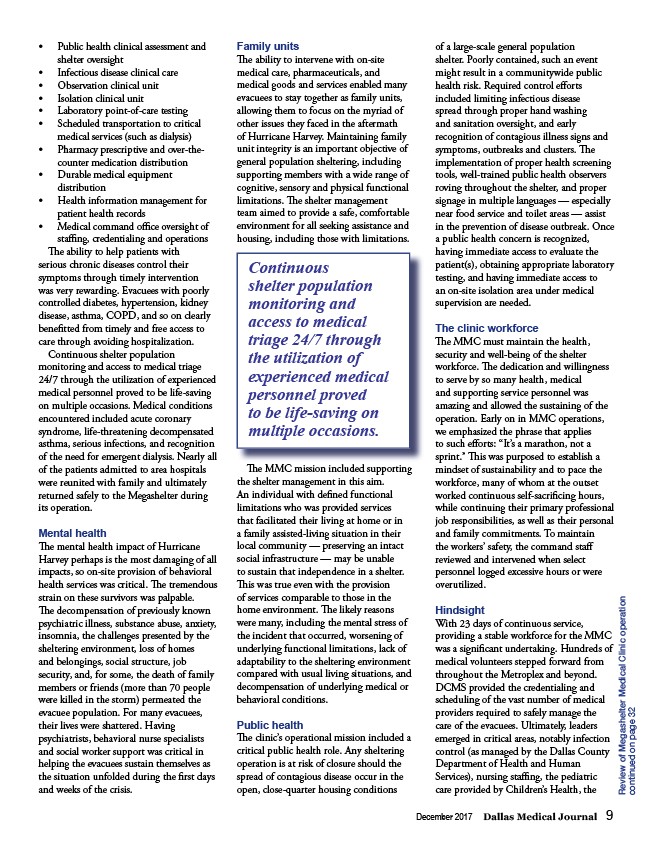
of a large-scale general population
shelter. Poorly contained, such an event
might result in a communitywide public
health risk. Required control eff orts
included limiting infectious disease
spread through proper hand washing
and sanitation oversight, and early
recognition of contagious illness signs and
symptoms, outbreaks and clusters. Th e
implementation of proper health screening
tools, well-trained public health observers
roving throughout the shelter, and proper
signage in multiple languages — especially
near food service and toilet areas — assist
in the prevention of disease outbreak. Once
a public health concern is recognized,
having immediate access to evaluate the
patient(s), obtaining appropriate laboratory
testing, and having immediate access to
an on-site isolation area under medical
supervision are needed.
The clinic workforce
Th e MMC must maintain the health,
security and well-being of the shelter
workforce. Th e dedication and willingness
to serve by so many health, medical
and supporting service personnel was
amazing and allowed the sustaining of the
operation. Early on in MMC operations,
we emphasized the phrase that applies
to such eff orts: “It’s a marathon, not a
sprint.” Th is was purposed to establish a
mindset of sustainability and to pace the
workforce, many of whom at the outset
worked continuous self-sacrifi cing hours,
while continuing their primary professional
job responsibilities, as well as their personal
and family commitments. To maintain
the workers’ safety, the command staff
reviewed and intervened when select
personnel logged excessive hours or were
overutilized.
Hindsight
With 23 days of continuous service,
providing a stable workforce for the MMC
was a signifi cant undertaking. Hundreds of
medical volunteers stepped forward from
throughout the Metroplex and beyond.
DCMS provided the credentialing and
scheduling of the vast number of medical
providers required to safely manage the
care of the evacuees. Ultimately, leaders
emerged in critical areas, notably infection
control (as managed by the Dallas County
Department of Health and Human
Services), nursing staffi ng, the pediatric
care provided by Children’s Health, the
December 2017 Dallas Medical Journal 9
• Public health clinical assessment and
shelter oversight
• Infectious disease clinical care
• Observation clinical unit
• Isolation clinical unit
• Laboratory point-of-care testing
• Scheduled transportation to critical
medical services (such as dialysis)
• Pharmacy prescriptive and over-thecounter
medication distribution
• Durable medical equipment
distribution
• Health information management for
patient health records
• Medical command offi ce oversight of
staffi ng, credentialing and operations
Th e ability to help patients with
serious chronic diseases control their
symptoms through timely intervention
was very rewarding. Evacuees with poorly
controlled diabetes, hypertension, kidney
disease, asthma, COPD, and so on clearly
benefi tted from timely and free access to
care through avoiding hospitalization.
Continuous shelter population
monitoring and access to medical triage
24/7 through the utilization of experienced
medical personnel proved to be life-saving
on multiple occasions. Medical conditions
encountered included acute coronary
syndrome, life-threatening decompensated
asthma, serious infections, and recognition
of the need for emergent dialysis. Nearly all
of the patients admitted to area hospitals
were reunited with family and ultimately
returned safely to the Megashelter during
its operation.
Mental health
Th e mental health impact of Hurricane
Harvey perhaps is the most damaging of all
impacts, so on-site provision of behavioral
health services was critical. Th e tremendous
strain on these survivors was palpable.
Th e decompensation of previously known
psychiatric illness, substance abuse, anxiety,
insomnia, the challenges presented by the
sheltering environment, loss of homes
and belongings, social structure, job
security, and, for some, the death of family
members or friends (more than 70 people
were killed in the storm) permeated the
evacuee population. For many evacuees,
their lives were shattered. Having
psychiatrists, behavioral nurse specialists
and social worker support was critical in
helping the evacuees sustain themselves as
the situation unfolded during the fi rst days
and weeks of the crisis.
Family units
Th e ability to intervene with on-site
medical care, pharmaceuticals, and
medical goods and services enabled many
evacuees to stay together as family units,
allowing them to focus on the myriad of
other issues they faced in the aftermath
of Hurricane Harvey. Maintaining family
unit integrity is an important objective of
general population sheltering, including
supporting members with a wide range of
cognitive, sensory and physical functional
limitations. Th e shelter management
team aimed to provide a safe, comfortable
environment for all seeking assistance and
housing, including those with limitations.
Th e MMC mission included supporting
the shelter management in this aim.
An individual with defi ned functional
limitations who was provided services
that facilitated their living at home or in
a family assisted-living situation in their
local community — preserving an intact
social infrastructure — may be unable
to sustain that independence in a shelter.
Th is was true even with the provision
of services comparable to those in the
home environment. Th e likely reasons
were many, including the mental stress of
the incident that occurred, worsening of
underlying functional limitations, lack of
adaptability to the sheltering environment
compared with usual living situations, and
decompensation of underlying medical or
behavioral conditions.
Public health
Th e clinic’s operational mission included a
critical public health role. Any sheltering
operation is at risk of closure should the
spread of contagious disease occur in the
open, close-quarter housing conditions
Review of Megashelter Medical Clinic operation
continued on page 32
Continuous
shelter population
monitoring and
access to medical
triage 24/7 through
the utilization of
experienced medical
personnel proved
to be life-saving on
multiple occasions.